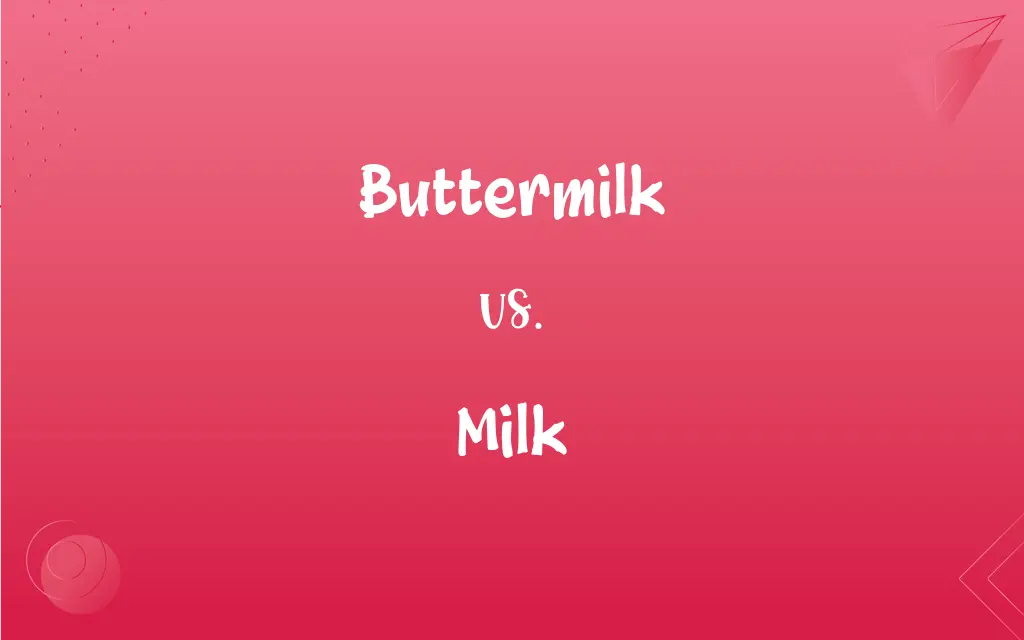Buttermilk vs. Milk: What's the Difference?
Edited by Aimie Carlson || By Harlon Moss || Updated on October 17, 2023
Buttermilk is a tangy byproduct of butter-making or fermented milk, while milk is a nutrient-rich liquid from mammals, usually cows.

Key Differences
Buttermilk and milk are both derived from mammals, predominantly cows in many cultures. While milk serves as a primary source of nutrition for newborn mammals and humans, buttermilk originally referred to the liquid left after churning butter from cream. The tanginess and distinct flavor of buttermilk set it apart from the creamy and neutral taste of milk.
In modern times, buttermilk available in stores often refers to cultured buttermilk. This version is made by introducing lactic acid bacteria to milk, which ferments the lactose and gives buttermilk its signature tang. Milk, in its natural state, does not possess this tanginess, though it can sour if left exposed or past its expiration.
Both buttermilk and milk are versatile kitchen ingredients. Buttermilk, due to its acidity, is frequently used in baking as it can react with baking soda to aid in rising. Milk is a staple in many recipes, from sauces to desserts, and is often consumed on its own due to its rich nutritional profile.
Nutritionally, buttermilk tends to be lower in fat compared to regular milk since it's a byproduct of the butter-making process where most fat is removed. However, milk contains essential nutrients like calcium, protein, and vitamins, making it a crucial part of many diets worldwide.
Whether used for cooking, baking, or drinking, both buttermilk and milk have secured their spots in culinary traditions across the globe. The sharpness of buttermilk contrasts with the smoothness of milk, yet both bring unique attributes to the table, enhancing the dishes they're incorporated into.
ADVERTISEMENT
Comparison Chart
Origin
Byproduct of butter-making or fermented milk
Liquid from mammals
Taste
Tangy and acidic
Creamy and neutral
Use in Baking
Reacts with baking soda for rising
Adds moisture and creaminess
Fat Content
Generally lower in fat
Varies (skim, 2%, whole, etc.)
Fermentation
Often cultured with lactic acid bacteria
Not fermented unless purposely done
ADVERTISEMENT
Buttermilk and Milk Definitions
Buttermilk
A fermented dairy drink with a distinct sour taste.
She enjoyed a cold glass of buttermilk on a hot day.
Milk
A white liquid produced by female mammals to feed their young.
Every morning, he drank a glass of milk for breakfast.
Buttermilk
Often used in baking due to its acidic properties.
The buttermilk reacted with the baking soda, making the cake rise perfectly.
Milk
Used in a variety of culinary dishes, from savory to sweet.
The creamy sauce was made with a base of milk and butter.
Buttermilk
A dairy product lower in fat due to butter extraction.
For a lighter option, she chose buttermilk over whole milk.
Milk
A primary source of calcium, vitamins, and protein.
Parents often give children milk to support their growing bones.
Buttermilk
Can be cultured by adding bacteria to milk.
The store-bought buttermilk was cultured for a consistent flavor.
Milk
Can be processed into various dairy products like cheese, yogurt, and butter.
The cheese is made by curdling milk and then aging it.
Buttermilk
Liquid leftover after churning butter from cream.
The pie recipe calls for a cup of buttermilk for added tanginess.
Milk
Varies in fat content, leading to options like skim, whole, and 2%.
She preferred skim milk as it was lower in calories.
Buttermilk
The liquid, usually either naturally soured or cultured with acid-producing bacteria, that remains after the butterfat has been removed from cream by churning.
Milk
A whitish liquid containing proteins, fats, lactose, and various vitamins and minerals that is produced by the mammary glands of all mature female mammals after they have given birth and serves as nourishment for their young.
Buttermilk
A sour milk made by culturing usually skim milk with acid-producing bacteria.
Milk
The milk of cows, goats, or other animals, used as food by humans.
Buttermilk
The liquid left over after producing butter from full cream milk by the churning process, also called traditional buttermilk.
Buttermilk
Cultured buttermilk, a fermented dairy product produced from cow's milk, with a characteristically sour taste.
Buttermilk
The milk that remains after the butter is separated from the cream.
Buttermilk
Residue from making butter from sour raw milk; or pasteurized milk curdled by adding a culture
FAQs
Is buttermilk just sour milk?
No, while both are tangy, buttermilk is a specific byproduct of butter-making or is milk fermented with bacteria.
Can buttermilk be drunk like milk?
Yes, many people enjoy its tangy flavor, especially in certain cultures.
Can milk replace buttermilk in recipes?
Not directly, but you can add vinegar or lemon juice to milk to mimic buttermilk's acidity.
Can you make buttermilk at home?
Yes, by adding lemon juice or vinegar to milk or fermenting milk with specific cultures.
Can I make cheese from buttermilk?
Yes, certain cheeses can be made using buttermilk as a starter culture.
How is skim milk made?
By removing a portion or all of the fat content from whole milk.
Can I use buttermilk in smoothies?
Yes, it can add a tangy flavor and creamy consistency to smoothies.
Which has more fat: whole milk or buttermilk?
Typically, whole milk, as buttermilk is lower in fat due to butter extraction.
Why does milk sometimes curdle in coffee?
Due to the coffee's acidity or temperature differences between the coffee and milk.
Is buttermilk healthier than milk?
Both have nutritional benefits, but buttermilk is generally lower in fat. Individual health needs should guide preference.
Why is buttermilk used in baking?
Its acidity reacts with baking soda, helping baked goods rise.
How is milk pasteurized?
By heating it to a specific temperature to kill harmful bacteria, then cooling it rapidly.
Why is milk considered nutritious?
It provides essential nutrients like calcium, protein, and vitamins.
Is lactose-free milk real milk?
Yes, it's milk with the lactose sugar broken down or removed.
Are there non-dairy versions of buttermilk?
Not traditionally, but you can mimic its tanginess with alternatives like soy or almond milk mixed with an acid.
How should milk and buttermilk be stored?
Both should be refrigerated to maintain freshness.
Is chocolate milk just milk and chocolate?
Mostly, but it often contains sweeteners and other flavorings.
What gives buttermilk its tangy flavor?
The presence of lactic acid from fermentation or the butter-making process.
Can milk be frozen?
Yes, but texture and consistency might change upon thawing.
Is buttermilk suitable for lactose-intolerant individuals?
Often yes, as the fermentation process can break down some lactose.
About Author
Written by
Harlon MossHarlon is a seasoned quality moderator and accomplished content writer for Difference Wiki. An alumnus of the prestigious University of California, he earned his degree in Computer Science. Leveraging his academic background, Harlon brings a meticulous and informed perspective to his work, ensuring content accuracy and excellence.
Edited by
Aimie CarlsonAimie Carlson, holding a master's degree in English literature, is a fervent English language enthusiast. She lends her writing talents to Difference Wiki, a prominent website that specializes in comparisons, offering readers insightful analyses that both captivate and inform.































































